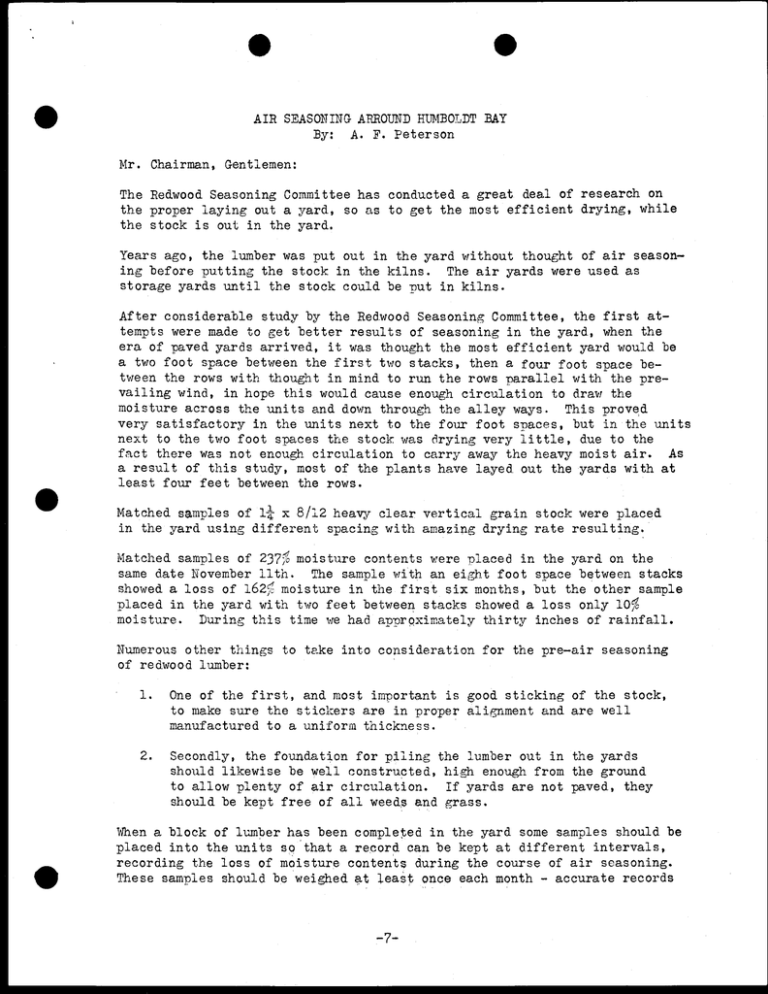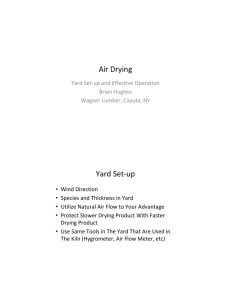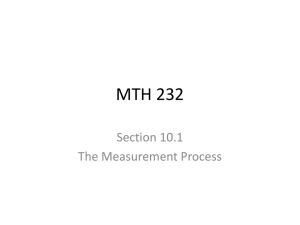•
advertisement

• AIR SEASONING ARROUND HUMBOLDT BAY By: A. F. Peterson Mr. Chairman, Gentlemen: The Redwood Seasoning Committee has conducted a great deal of research on the proper laying out a yard, so as to get the most efficient drying, while the stock is out in the yard. Years ago, the lumber was put out in the yard without thought of air seasoning before putting the stock in the kilns. The air yards were used as storage yards until the stock could be put in kilns. • After considerable study by the Redwood Seasoning Committee, the first attempts were made to get better results of seasoning in the yard, when the era of paved yards arrived, it was thought the most efficient yard would be a two foot space between the first two stacks, then a four foot space between the rows with thought in mind to run the rows parallel with the prevailing wind, in hope this would. cause enough circulation to draw the moisture across the units and down through the alley ways. This proved very satisfactory in the units next to the four foot spaces, but in the units next to the two foot spaces the stock was drying very little, due to the fact there was not enough circulation to carry away the heavy moist air. As a result of this study, most of the plants have layed out the yards with at least four feet between the rows. Matched samples of 1* x 8/12 heavy clear vertical grain stock were placed in the yard using different spacing with amazing drying rate resulting. Matched samples of 237% moisture contents were placed in the yard on the same date November 11th. The sample with an eight foot space between stacks showed a loss of 162% moisture in the first six months, but the other sample placed in the yard with two feet between stacks showed a loss only 10% moisture. During this time we had ap proximately thirty inches of rainfall. Numerous other things to take into consideration for the pre-air seasoning of redwood lumber: 1. One of the first, and most important is good sticking of the stock, to make sure the stickers are in proper alignment and are well manufactured to a uniform thickness. 2. Secondly, the foundation for piling the lumber out in the yards should likewise be well constructed, hi gh enough from the ground to allow plenty of air circulation. If yards are not paved, they should be kept free of all weeds and grass. When a block of lumber has been completed in the yard some samples should be placed into the units so that a record can be kept at different intervals, recording the loss of moisture contents during the course of air seasoning. These samples should be weighed at least once each month - accurate records -7- should be kept of these weighings so the lumber will not be rut in kilns while stock is too heavy, nor remain in yards longer than is necessary. If all stock could be air seasoned, to around fifty percent moisture content before going into the kilns, then the kiln operator could finish drying the stock very efficiently. Around Humboldt Bay Area we have a much different drying condition than anywhere else, due to the fact that we have a great deal of rain four or five months of the year, some years as much as forty-five inches of rainfall. The temperature does not vary more than a few degrees the year around, the average temperature is 56° with a humidity of 80% most every day. Even under these conditions, during the rainy season the lumber will lose moisture very fast, provided that we get a lot of circulation due to windy season. (Show graph of the difference in drying for different spacings of lumber in the yards). To date some of the companies in the redwood region are working on the experiment of putting large power driven fans in the yard to increase the drying rate in the air yards. This experiment has shown some gratifying results, but the cost of installation on a large scale may prove to be prohibitive. One sample directly in front of the fan showed a loss of 140% moisture in 123 days. Piled on 12" high foundations, 5 feet between rows 1 x 8/12 heavy clear V.G. - 5 foot alleys. Total loss of M.C, (117%) by number of days in yard (146 days) = .80% M.C. loss per day. .80 146/117.00 116 8 197 .1. 80 = 277 ; 2 7 138 average M.O. M.C. loss per day (.80%) ; by average M.C. (138%) = drying factor. .0058 drying factor 138/.80000 690 1100 1104 Pile on 12" foundation with 2' between piles. 265 days in the yard by total loss of M.C. 64% = .241% P,10. loss per day drying rate. .241% loss per day 265/640.000 530 1100 1060 400 -8- • • 201 137 = 338 s 2 = 169 average M.O. M.O. % loss per day (.241%) -:- by average M.C. (169%) equals drying factor. 201% M.O. started in the yard - 137% after 265 days in the yard .0014 drying factor 169000/241.0000 169 720000 676000 Thank you. EXPERIMENTS IN YARD SPACING By: W. R. MacPherson Mr. Chairman, Gentlemen: have to make on air drying supplement those of Mr. Lane and The remarks Mr. Petersen. First, I would like to define two terms that I will use. Test Block - Those units of lumber piled on an individual set of pile bottoms between two access alleys. Spacing - That distance of air space between the tiers of units in a test block. In the latter part of 1950 and the early part of 1951 Mr. Clayton and Mr. Benjamin of Hammond Lumber Co, Plant 2, Eureka, Calif. tested the rate of air drying of 4/4 heavy uppers on 2-71)', 3 and 5 foot spacings. The results of this test were so decidedly in favor of the 5 foot spacing that the management of Arcata Redwood Co. felt that further work should be done to determine the yard spacing that would yield the maximum drying rate and the best uniformity of moisture content at the least cost. It was decided to test the rate and uniformity of air drying on 4, 6 and 8 foot spacings. The following grades and thicknesses were used as test blocks on each of the three spacings: 1, 4/4 heavy uppers light uppers heavy shop 2. 5/4 heavy uppers 3. 6/4 light uppers light shop A drying yard of approximately were to be conducted. 3.5 acres was developed on which the tests -9- • The five access alleys were located north and south, and those blocks along the edges of the yard were filled first using a four foot spacing. The blocks in the test alleys were filled next with the exception of the locations designated for the test blocks. This was done to block off the direct wind and to minimize any accelerated drying of a test block due to an exposed position in the yard. Sample pockets were built into the units in the standard manner. After the test blocks were filled, the sample boards were placed in the pockets according to a predetermined location plan for each test block. These sample boards were weighed every month as near as possible. The moisture content limits were set, for heavy samples at 175-250% and for light samples, 60-100%. All of the test blocks were completed by the middle of September 1951. Data will be collected until the test blocks reach an average of 40% moisture content when they will be taken into the kilns. The information compiled from the data so far is incomplete and inconclusive but it does give an indication of what the final results might be. The 4 foot spacing dried so slowly and gave such a poor uniformity in moisture content compared with the 6 and 8 foot spacings that it will be discontinued and replaced with a 5 foot spacing. The 6 foot spacing dried considerably faster than the 4 foot and approached the 8 foot spacing drying rate. Another check will be made with two more test blocks to determine if this isn't somewhat of a yard locational effect or an experimental error inherent in the data. A definite pattern of moisture content in relation to location in the test block was apparent in the 4 and 6 foot spacings. The eight foot spacing dried the fastest, and based on maximum kiln production, and the rates of annual turnover for 6 and 8 foot spacings, rough calculations show that the 8 foot spacing would require less air yard area and would also be cheaper per thousand. There was no definite moisture content location pattern as there was in 4 and 6 foot spacings. Some factors other than location may exert more influence on moisture content uniformity in 8 foot spacing than on the 4 and 6 foot spacings. The results of these tests will be made available through the California Redwood Association. I have a few slides to show pertaining to these remarks. • 1. 2. 3. 4. 5. Air view of plant-site and air yard. End view of 4, 7 and 8 foot spacings. Curve of drying from 200% on 4, 6, and 8 foot spacings. Average corrected drying rate factor over spacing. Moisture content uniformity. Thank you. -10-





